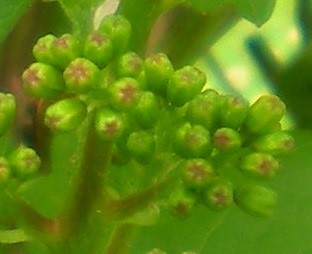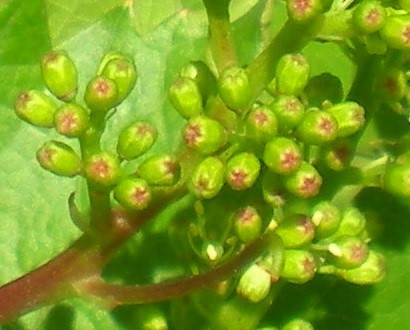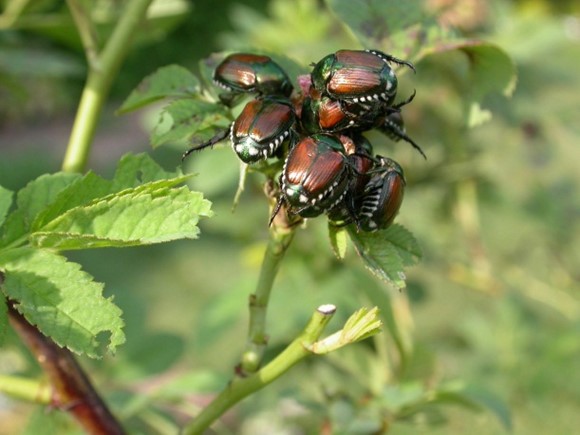Vinews
No. 6 — June 1, 2020
Contents:
- Critical Period of Disease Management
- First Report of Japanese Beetles for the 2020 Season
- Cumulative Growing Degree Days for the Seven Grape Growing Regions of Missouri from April 1 to May 30, 2020
- Weather Outlook
Critical Period of Disease Management


Disease management from 1/2-inch shoots until the period of pre-bloom is fairly straightforward. Once immediate pre-bloom begins, the number of potential pathogens increases. Two factors that play a critical role during this period are the environment and a change from grapevine vegetative growth to sexual growth. It is very important to recognize and be able to identify different stages of grapevine growth and development. Immediate pre-bloom is the stage when the florets on the inflorescence begin to separate from each other (Figure 1). At this stage, no flowers are opening. After immediate pre-bloom, the time to bloom is rapid in a “normal” growing season. Full bloom is when 50% of the flowers are open on 5% of the inflorescences. Bloom is often completed in four to six days.
Protecting grapevines from pathogens from immediate pre-bloom to the end of bloom is critical. For most all grape cultivars during this critical period the application of a systemic fungicide is tank mixed with a protectant fungicide. The systemic fungicide will provide a longer period of protection than a protectant fungicide applied alone. If rainfall occurs during the period from immediate pre-bloom to post-bloom, the systemic fungicide will provide control. There are a number of good systemic fungicides and combination systemic fungicides. The question always becomes which one to use.
Before considering what fungicide or fungicide combination to use determine what pathogens were a problem last season and identify which cultivars had the most disease issues. At immediate pre-bloom the major pathogens that cause disease are black rot, phomopsis, downy mildew, powdery mildew, anthracnose, and botrytis. Almost all fungicides and combination fungicide products have spectrum weaknesses in which they will not control a particular pathogen. For example, the DeMethylation Inhibitors (DMI) (FRAC code 3) Rally, TubuStar, and Vintage are not effective in controlling Downy mildew or Botrytis. Another example — Some of the Quinone outside Inhibitors (Qol) that are often referred to as Strobilurins such as Flint and Sovran have poor activity against downy mildew. A way around these spectrum weaknesses is to tank mix with another fungicide that is effective in controlling the pathogen. In the two examples above, a tank mix with mancozeb or Captan would provide protection to downy mildew. Depending on your cultivars time to predicted harvest, remember the pre-harvest intervals (PHI) — especially for mancozeb containing products have a 66 day PHI.
Tank mixing products from different FRAC groups is also a good fungicide resistant management plan. Mixing a strobilurin fungicide &emdash; Sovran (FRAC 11) with Captan (FRAC M) reduces the potential for the development of a pathogen developing resistance. The Captan also provides protection from Downy mildew whereas Sovran has limited efficacy on Downy mildew. Do not apply Strobilurins (FRAC 11), DMI inhibitors (FRAC 3) more than two times consecutively. Notice that all the combination fungicides listed in Table 1 have DMI inhibitors (FRAC 3) included in the combination except Pristine. I good fungicide resistant management plan includes rotating fungicide products from different FRAC codes. An example of a poor rotation would be to apply Rally (FRAC 3) tank mixed with Captan (FRAC M) twice with the next cover spray being any of the combination products that contain a FRAC 3 code. That eliminates 4 out of 5 fungicide products listed in Table 1 except Pristine (FRAC 7+11).
As bloom ends, the first two weeks after bloom are critical in managing for pathogens. As the berries age they develop resistance to downy mildew, powdery mildew, and black rot, but this does not occur until four to five weeks post bloom. As bloom ends, Phomopsis spores are diminished. Anthracnose can continue to be a problem throughout the growing season. Strobilurins (Frac 11), Combination products, and DMI inhibitors (FRAC 3) all provide excellent management of Anthracnose except Luna experience.
Continue to be vigilant in scouting and with timely fungicide applications. Select fungicides that will provide control of all the major pathogens. Tank mixing a systemic fungicide product with a protectant fungicides such as mancozeb, Captan or Ziram is beneficial for fungicide resistance management, expands the spectrum of control when a particular fungicide has a spectrum weakness and the systemic provides you some time should an extended rain period occur. Remember to rotate fungicides with different FRAC codes.
| Fungicide Product | Frac code |
Black rot |
Downy mildew |
Powdery mildew |
Phomopsis | Anthracnose | Botrytis |
|---|---|---|---|---|---|---|---|
| Quinone Outside Inhibitors | |||||||
| Abound | 11 | 2E | E | E | F | E | G |
| Flint | 11 | E | F | E | F | E | G |
| Sovran | 11 | E | G | E | F | E | G |
| DMI Inhibitors | |||||||
| Rally | 3 | E | 0 | E | 0 | E | 0 |
| TebuStar | 3 | E | 0 | E | 0 | E | 0 |
| Vintage | 3 | E | 0 | E | 0 | E | 0 |
| Combination Fungicides | |||||||
| Inspire Super | 3+9 | E | 0 | E | 0 | E | E |
| Luna Experience | 3+7 | G | G | E | G | 0 | E |
| Pristine | 7+11 | E | E | E | F | E | G |
| Quadris Top | 3+11 | E | E | E | F | E | G |
| Revus Top | 3+40 | E | E | E | 0 | E | unknown |
| Protectant Fungicides | |||||||
| Captan | M | F | E | 0 | E | E | F |
| Mancozeb | M | E | E | 0 | E | E | 0 |
| Ziram | M | E | G | 0 | G | G | 0 |
1 All data in table transcribed from the Midwest Fruit Pest Management Guide 2019-2020.
2 E=Excellent. G=Good. F=Fair. 0=not effective. Unknown=effectiveness unknown or not established
First Report of Japanese Beetles for the 2020 Season

On June 5, 2020, Japanese beetles were reported in Central Northeast Missouri, specifically Boone County. The Japanese beetles were reported on the University of Missouri Integrated Pest Management website. The trapping network has 11 sites around Missouri trapping for Japanese beetles. The Japanese beetles were caught in a pheromone trap. You can sign up to receive pest alerts from the IPM website. The trapping network is conducted by MU regional agronomy and horticulture extension professionals.
With wet soil conditions throughout most of Missouri, there will be an opportunity for the adults to easily emerge in the coming days and weeks. A natural enemy of Japanese beetles has been established in Missouri. A small wasp, Tiphia vernalis (Hymenoptera Tiphiidae), parasitizes the Japanese Beetle larva. Hopefully biocontrol agents will help reduce Japanese beetle populations.
Cumulative Growing Degree Days for the Seven Grape Growing Regions of Missouri from April 1 to May 30, 2020
| Region | Location by County | Growing Degree Days1 | ||
|---|---|---|---|---|
| 2020 | 2019 | 30-year Average | ||
| Augusta | St. Charles | 617 | 765 | 740 |
| Hermann | Gasconade | 586 | 758 | 725 |
| Ozark Highland | Phelps | 624 | 828 | 785 |
| Ozark Mountain | Lawrence | 628 | 807 | 756 |
| Southeast | Ste. Genevieve | 631 | 807 | 788 |
| Central |
Boone | 619 | 744 | 716 |
| Western | Ray | 575 | 653 | 694 |
1 Growing degree days at base 50 from April 1 to May 30, 2020. Data compiled from Useful and Useable at https://mrcc.illinois.edu/U2U/gdd/. Click on link below to determine growing degree days in your area.
To determine the number of growing degree days accumulated in your area since April 1, use this tool.
Weather Outlook
Weather Outlook for June 8-12
- Above normal high temperatures predicted. The temperatures this week and next week are more typical of July.
- Above normal precipitation predicted.
May highlights
- The month of May was 2 to 3 °F below normal.
- Central Missouri was dry during May with rainfall being approximately two inches below normal.
- The top and bottom third of Missouri had a lot of rain during the month of May and remain fairly wet.